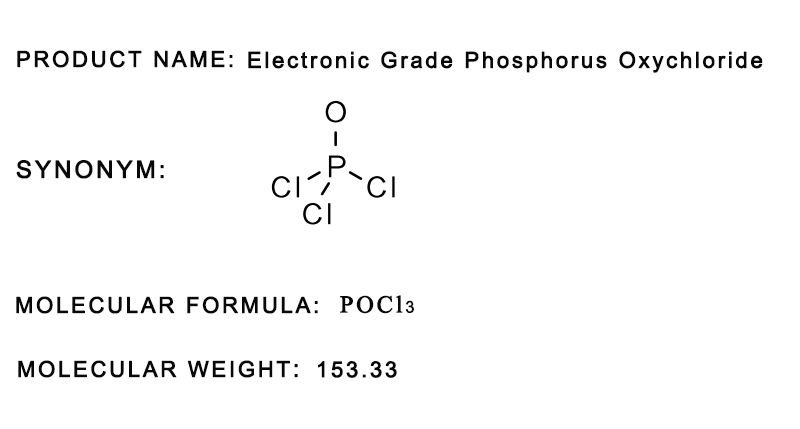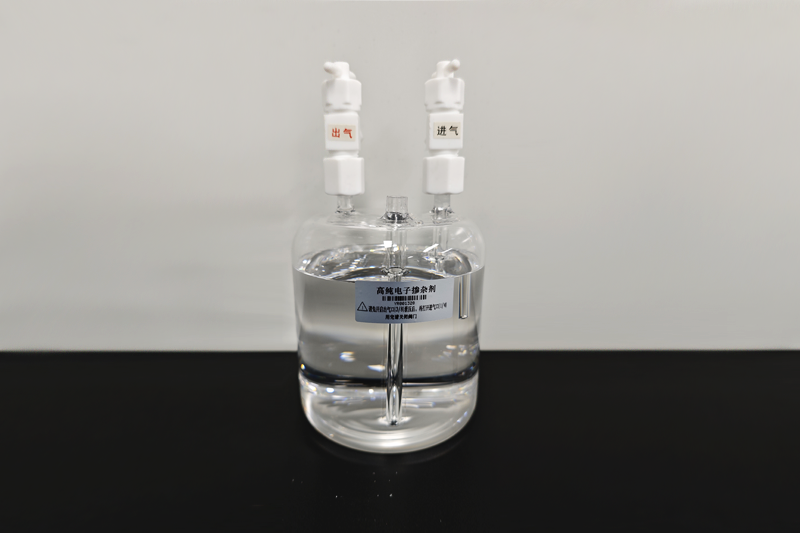product details :

Testing Items | Technical Indicator 6N level | Technical Indicator 7N level |
Phosphorus trichloride (POCl3)w/%≥ | 99.9 | 99.9 |
Purity (based on cations) w/%≥ | 99.9999 | 99.99999 |
Aluminum(Al)w/(μg/kg)≤ | 20 | 5 |
Antimony(Sb)w/(μg/kg)≤ | 10 | 3 |
Arsenic(As)w/(μg/kg)≤ | 15 | 6 |
Barium(Ba)w/(μg/kg)≤ | 10 | 1 |
Bismuth(Bi)w/(μg/kg)≤ | 10 | 1 |
Cadmium(Cd)w/(μg/kg)≤ | 10 | 3 |
Calcium(Ca)w/(μg/kg)≤ | 20 | 5 |
Chromium(Cr)w/(μg/kg)≤ | 10 | 1 |
Cobalt(Co)w/(μg/kg)≤ | 10 | 1 |
Copper(Cu)w/(μg/kg)≤ | 20 | 2 |
Gallium(Ga)w/(μg/kg)≤ | 1 | 1 |
Gold(Au)w/(μg/kg)≤ | 1 | 1 |
Iron (Fe)w/(μg/kg)≤ | 30 | 5 |
Lead(Pb)w/(μg/kg)≤ | 10 | 3 |
Lithium (Li)w/(μg/kg)≤ | 10 | 6 |
Magnesium(Mg)w/(μg/kg)≤ | 10 | 5 |
Manganese(Mn)w/(μg/kg)≤ | 20 | 1 |
Mercury(Hg)w/(μg/kg)≤ | 10 | 5 |
Nickel(Ni)w/(μg/kg)≤ | 10 | 1 |
Niobium(Nb)w/(μg/kg)≤ | 2 | 1 |
Potassium(K)w/(μg/kg)≤ | 20 | 3 |
Silver(Ag)w/(μg/kg)≤ | 1 | 1 |
Sodium(Na)w/(μg/kg)≤ | 10 | 5 |
Tin(Sn)w/(μg/kg)≤ | 5 | 1 |
Strontium(Sr)w/(μg/kg)≤ | 5 | 1 |
Titanium(Ti)w/(μg/kg)≤ | 5 | 2 |
Vanadium(V)w/(μg/kg)≤ | 10 | 2 |
Zinc(Zn)w/(μg/kg)≤ | 5 | 1 |
Chromaticity/APHA≤ | 5 | 5 |
Particles(≥0.3μm)/(individual/mL)≤ | 50 | 50 |
Electronic grade phosphorus trichloride emits strong smoke in humid air, reacts violently with water to produce phosphoric acid, and releases hydrogen chloride gas, which decomposes when heated. During the sampling, testing, and handling processes, it is important to take protective measures. Wear protective equipment such as glasses, masks, and rubber gloves when in contact. It is strictly prohibited to come into contact with water, avoid inhaling steam, and avoid contact with skin and mucous membranes. When a leak occurs, it should be treated with sediment or lime. If it has come into contact with the skin, it should be immediately rinsed with plenty of running water.
1. Packaged in quartz material containers. The container is placed in a wooden box or plastic box with foam. Belonging to hazardous chemicals, transportation should be carried out in accordance with the requirements of the dangerous goods transportation regulations. It should be stored in a cool, dry, and well ventilated warehouse, away from fire and heat sources. It should be stored separately from reducing agents, active metal powders, alcohols, etc. The storage area should be equipped with emergency response equipment for leaks and suitable containment materials.

